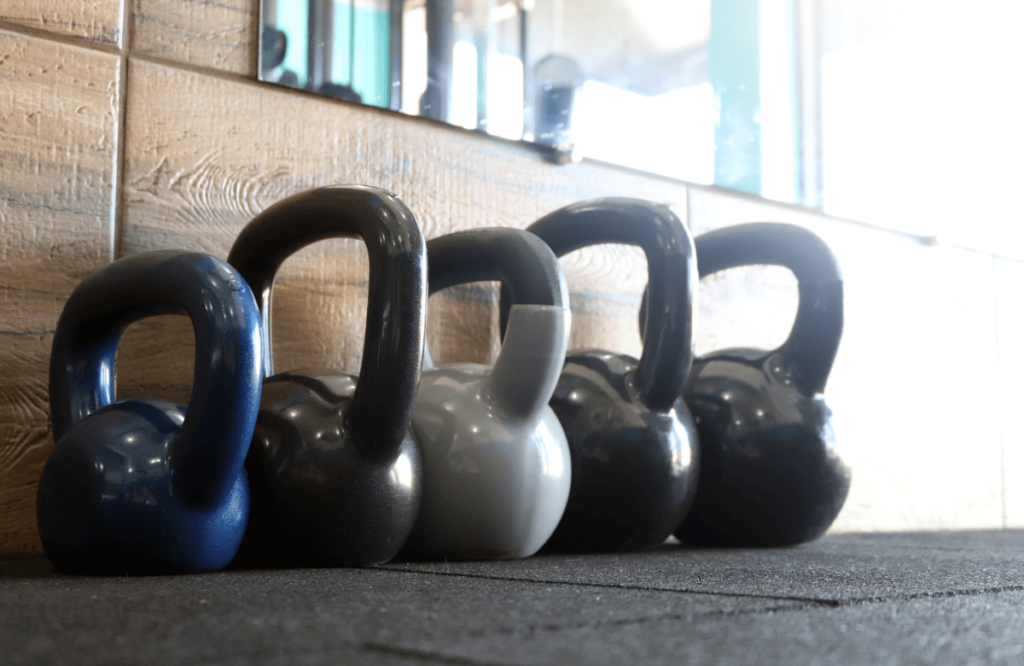The kettlebell halo is one of the most looked-for exercises for improving shoulder health and mobility.
It’s beginner friendly, although it can be an interesting ingredient for increasing intensity in more advanced training programs.
When done properly, the halo movement is a shoulder opener and strengthener and a core training staple.
This article will cover the kettlebell halo exercise: technique, muscles worked, and benefits. You’ll also find a workout to get you moving right away!
Jump to:
What Is The Kettlebell Halo Exercise?
According to Cambridge’s dictionary, a halo is a circle of light shown around or above a saint or holy person’s head to represent their holiness.
The kettlebell halo exercise comes from that “halo” shape resemblance when going around and up the head.
The halo rotation is enabled by the shoulder muscles and stabilized by the core. It’s an excellent movement to improve overhead shoulder mobility even if you don’t play any particular sport and are just looking for a pair of healthy shoulders.
This movement has a low barrier to entry. It’s intuitive, easy to master, fun, and effective!

Technique And Form
Although the halo exercises are relatively simple, it’s always wise to double down on technique and form to ensure maximal results and avoid shoulder pain.
Many people have limited shoulder motion and are often unaware of it. Ramping up the intensity and weight load before mastering the technique could increase the risk of injury.
Let’s break down these kettlebell halo form tips to enjoy all the benefits this exercise can bring.
Starting position
The starting position can vary depending on the halo variation; some of the most common are:
– Standing position
– Tall kneeling position
– Half-kneeling position
– Lunge position
– Seated position.
Let’s take the standing position as an example. In this setup, you want your feet shoulder-width or wider. You can play with this until you find a comfortable stance.
Contract your glute muscles and keep your core engaged; this will help you maintain a neutral spine position throughout the movement.
Hold the kettlebell by the handles at chest height with the bottom facing up and the handles down. Make sure to use an overhand grip and keep your shoulder blades retracted.
Movement Technique
Bring the kettlebell towards one shoulder while sending the other over the head. Next, pass the kettlebell close to your ear until you reach the bottom of your neck.
You should feel a nice stretch on your triceps in this position. Then, bring the kettlebell to the front of the opposite shoulder and continue until you get back to chest height.
While the movement is going, keep the core stable and move slowly, keeping the center of gravity.
You can continue the reps in the same direction or change it rep by rep.

Common Mistakes
Despite the halo exercise being beginner-friendly and easy to do, there are key elements to consider that avoid taking full advantage of the movement.
Up next, we’ll review the most common mistakes people make when starting with the kettlebell halo exercise. Thankfully, all of them should be easy to address and rectify.
Weight Too Heavy
If you’re trying the movement for the first time, a common mistake would be choosing a heavier weight than you can handle.
A regular halo is supposed to feel smooth and continuous. It’s not to say that you should always aim for lighter weights, but try to put technique first.
This exercise can improve your shoulder mobility and health, but starting too aggressively may be harmful, especially if you’re a beginner.
Pick a weight that you can do 15-20 reps without stopping, and when you no longer feel it challenging, consider increasing the load.
Going Too Fast
Going too fast with any exercise is tempting. It feels almost natural. However, it can also be detrimental and counterproductive.
The goal of the halo exercise is to improve shoulder mobility and muscle endurance, and in order to do that, you need to spend appropriate time under tension.
If you go too fast, you won’t be able to feel the movement work the way it’s supposed to.
When you perform the exercise with a controlled tempo, it becomes the shoulder strengthener it is, and you minimize the risk of injury.
Inactive Core
The kettlebell halo can help you build core strength if you keep it active the entire time. Sadly, an inactive core is one of the most common errors we see.
And if you’re wondering what an inactive core means or looks like, picture moving something around your head while your torso and hip are going all over the place.
To prevent this, remember the starting position; contract your glutes to lock your hips, breathe into your belly and contract your core muscles to neutralize your spine.
Once you activate your core, then hold it throughout the entire movement.

Kettlebell Halo: Muscles Worked
Most of your kettlebell halo efforts will translate into stronger, healthier shoulders, upper-mid back, and core.
These muscles will work according to halos’ variation, weight, and reps.
You can use this movement as part of your warm-up before compound or isolated movements or leave it for the end of your training session as a finisher.
Shoulders
The halo is one of the few exercises that takes the shoulder through almost a complete range of motion, which is why it’s so looked for shoulder strength.
The shoulders, especially the rotator cuff muscles (supra/infraspinatus, teres minor, and sub-scapular), will get the most exposure in a kettlebell halo routine.
However, this movement will also target other muscles like the anterior, medial, and posterior deltoids. Particularly as the fatigue starts to build up.
After 3-5 halos with the right weight, you’ll feel your shoulders burning.
Upper-Mid Back
The upper-mid back is formed by the trapezius (upper, medial, lower section), rhomboids, levator scapulae, neck extensor, and rotator cuff muscles.
Spending more time under tension causes these muscles to fire simultaneously, allowing the shoulder girdle to move freely and smoothly throughout the exercise.
Even if you choose a lightweight, these muscles will have difficulty keeping up with the intensity. Simply make sure to go slow and controlled before fast and heavy.
Core
The halo movement is fantastic for core health. Because the kettlebell moves around the head, it constantly pushes the body in all directions.
This represents a core challenge. Muscles like external/internal obliques, rectus anterior, transverse abdominis, erector spinae, and quadratus lumborum will be worked the most in a halo kettlebell workout.
To get the most out of these muscles, contract your glutes to lock your hips, breathe in towards your belly, hold the air, and contract the core muscles before initiating the movement.

Benefits
The halo movement is one of the go-to exercises for improving thoracic and shoulder mobility, independent of your fitness levels.
Besides being a relatively easy movement to master, it holds many benefits that will persuade anyone to include it in their training programs.
Shoulder Mobility And Endurance
The halo exercise is the holy grail for shoulder mobility. The type of movement needed to get a kettlebell around your head will certainly put your shoulder motion to the test.
The halo can take the shoulder girdle to almost its entire range of motion through one rep. Even if, as a beginner, that range is limited, it opens up gradually.
Many upper body muscles will be put to an endurance test to achieve this. The halo is not an exercise for heavy weights but for lighter ones.
This gives it the ability to experience a higher rep range, thus building muscle resilience and endurance. That is crucial if you want to develop stronger and healthier shoulders.
Core Stability
Core stability is the precursor to core strength. The more resilient our midline becomes to external loads, the stronger our body gets.
A stable core is not only meant for athletic purposes (although it helps tremendously) but also a gold stamp for healthy living.
Being able to experience daily life with a strong body is a feeling most people should strive for. A stable core can help you undergo many daily activities reducing the chances of getting a painful back injury.
It’s also a key component for sustaining a healthy posture without getting into a compromised body position.
Kettlebell Halo Variations
One of the aspects that makes the kettlebell halo so accessible is the multiple variations it has.
Each can be performed by beginners, intermediate, and more experienced individuals.
Some variations don’t require a kettlebell; you can use other tools like dumbbells, plates, and medicine balls. Take a look!
Half-Kneeling Kettlebell Halo
Seated Plate Halo
Standing Dumbbell Halo
Tall-Kneeling Med-ball Halo
Kettlebell Goblet Squat + Halo
Tall-Kneeling Kettlebell Hip to Hip Halo
Feel free to try any of these kettlebell halo variations to mix up your training routine and make it more fun!
Try This Kettlebell Halo Workout
Now it’s time to put everything to practice!
Remember the technique foundation, avoid common mistakes, and pick a kettlebell weight according to your fitness level and training goal.
With these few elements in mind, you’ll enjoy the kettlebell halo’s benefits to the max.
This workout will be a 15-minute AMRAP (as many rounds as possible) which will target your shoulders, core, and arms, so make sure to pick a steady pace to avoid an early muscle failure.
Good luck, and enjoy!
| 15-Minute Kettlebell Halo AMRAP | ||
| Movement | Reps | Notes |
| Half-Kneeling Kettlebell Halo | 5 each direction | Go slow and controlled. |
| Kettlebell Goblet Squat | 12 | Lock knees and hips at the top. |
| Tall-Kneeling Kettlebell Hip to Hip Halo | 5 each direction | Slow and controlled. |
| American Kettlebell Swing | 12 | Strong drive up with the hips, lock elbows at the top. |
| Standing Kettlebell Halo | 5 each direction | Focus on a big range of motion. |
| Kettlebell Deadbug | 10 each leg. | Brace your core. |
Are Kettlebell Halos Effective?
Yes, they are! If you’re looking to gain muscle endurance in your upper body, along with improving your shoulder’s range of motion, then kettlebell halos are a perfect choice.
What Does A Kettlebell Halo Work?
The kettlebell halo works the shoulder and core muscles more than anything. It improves mobility around the shoulder joint and increases the core’s ability to resist movement in different planes.
How Many Kettlebell Halos Should You Do?
It depends on your fitness levels and personal goals. If you’re a beginner doing Halos for the first time, we recommend choosing lighter weights and staying within the 12-15 rep range per side per round.
Intermediate and more advanced individuals can handle heavier weights, more reps, and different variations.














